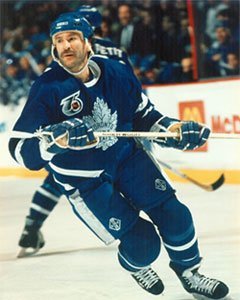
Twenty years ago … still feels like yesterday.
1991-92 was a season of note. In celebration of the NHL’s 75th anniversary, the Original 6 teams introduced throwback uniforms — the dawn of 3rd jerseys in the NHL. The San Jose Sharks entered the league as the first expansion team since the 1979 NHL/WHA merger. Top draft pick Eric Lindros refused to sign a contract with the Quebec Nordiques, leading to a controversial trade with the Philadelphia Flyers which would turn the Quebec franchise into a powerhouse. The league endured a 10-day NHLPA strike, resulting in the season ending in June for the first time. Following the season, longtime NHL President John Ziegler would step down, paving the way for Gary Bettman to take over as Commissioner in two years’ time.
It was a banner season for several players of note: Mario Lemieux captured the scoring title and led the Pittsburgh Penguins to their second consecutive Stanley Cup victory. Nine players topped the 100-point plateau, including Brian Leetch — a feat no defenseman has matched since. Jeremy Roenick and Kevin Stevens topped 50 goals for the first time each, while Brett Hull hit 70 goals for the third straight year. Legendary blueliner Larry Robinson played his final NHL game, while a future superstar named Martin Brodeur made his first appearance for the New Jersey Devils … who drafted another future superstar, Scott Neidermeyer, with a pick acquired two years’ prior from the Toronto Maple Leafs.
As for those lovable Leafs, change was in the air following yet another season in the cellar — with the team poised to take its first steps toward 1990s respectability.
..
Precursor
Flash back to the 1989-90 season, in which the Toronto Maple Leafs were an offensive juggernaut: Gary Leeman scored 51 goals, with Vincent Damphousse, Ed Olczyk and Daniel Marois contributing 33, 32, and 39 goals respectively — a feat all the more impressive considering team leader Wendel Clark missed 42 games with injury (and still managed 18 goals in 38 games). Mark Osborne recorded nearly a point per game filling in for Clark. Al Iafrate contributed 21 goals from the blueline, and fellow defender Tom Kurvers, acquired for a future 1st round pick, looked the part putting up 52 points in 70 games. Despite goaltender Allan Bester’s 4.49 GAA (Toronto teams were not exactly known for their defensive prowess in those days), the Leafs finished with a 38-38-4 record and made the playoffs. With the roster sporting an average age of 25, the future looked wonderfully bright.
Then came the 1990-91 season, a year which many Leafs fans have blocked from memory — and with good reason. Dogged by rumours of locker-room feuds and an ongoing ownership battle in the wake of Harold Ballard’s death, the Leafs stumbled to a 57-point season in which coach Doug Carpenter was fired after a 1-9-1 start, Leeman and Marois struggled mightily under the weight of expectation, and several players key to the team’s success the year before were sent packing including Olczyk and Osborne (Dave Ellett and Paul Fenton), Iafrate (Peter Zezel and Bob Rouse), Kurvers (Brian Bradley), Bester (Alexander Kuzminski), Lou Franceschetti (Mike Foligno), John MacIntyre (Mike Krushelnyski) and John Kordic (Alexei Kudashov). Even a relatively-healthy Wendel Clark could do little to stop the bleeding. By the end of the season, no one was sure what exactly had happened, or where exactly the Leafs were headed. But nearly all could agree the direction of the team was pointing anywhere other than “up”.
Immediately following the season, General Manager Floyd Smith was fired. He was replaced by longtime NHL General Manager Cliff Fletcher, whose Calgary Flames had won the 1989 Stanley Cup. Interim head coach Tom Watt, who had taken over for Doug Carpenter, was mercifully retained.
.
The Draft
The 1991 draft, while lacking a first round pick, did produce a couple of future NHL regulars in Yanic Perreault (3rd round) and Dmitri Mironov (7th round). However, it was a bitter pill for the Leafs to swallow when the Devils made Scott Neidermayer the 3rd overall selection with the pick they had traded two years’ prior for Tom Kurvers.
.
Off-Season Moves
Following the draft, Fletcher sent a future 3rd round pick (Vaclav Prospal) to the Philadelphia Flyers for veteran forward Mike Bullard (this guy, not this guy), with whom he was familiar from their days in Calgary. Just prior to the start of the season, Fletcher continued his quest to add leadership and character to the locker room, sending former first round picks Vincent Damphousse, Scott Thornton, Luke Richardson and goaltender Peter Ing to the Edmonton Oilers for a pair of veteran stars in Glenn Anderson and Grant Fuhr, as well as enforcer Craig Berube.
.
Early Season Roster
Entering the season, the roster depth stood as follows:
Forwards
Glenn Anderson, Brian Bradley, Mike Bullard, Craig Berube, Rob Cimetta, Wendel Clark, Lucien Deblois, Mike Eastwood, Tom Fergus, Mike Foligno, Dave Hannan, Mike Krushelnyski, Gary Leeman, Claude Loiselle, Daniel Marois, Kevin McLelland, Rob Pearson, Joe Sacco, Peter Zezel
Defenders
Drake Berehowsky, Dave Ellett, Len Esau, Todd Gill, Alexander Godynyuk, Bob Halkidis, Dmitri Mironov, Michel Petit, Bob Rouse, Darryl Shannon
Goaltenders
Grant Fuhr, Felix Potvin, Jeff Reese
All of these players would see varying degrees of playing time with the club, due to an onslaught injuries and numerous trades.
.
The Season Begins
Following an encouraging 2-1-0 start to the year, the Leafs immediately fell into a 7-game losing streak (sound familiar?), finishing the month of October with a 3-8-1 record. Hopes that the team could turn things around after some time to “gel” proved wishful thinking, as the Leafs would find themselves staring at a 10-25-5 record at the halfway point of the season, with the only moves to that point being the acquisition of Guy Larose (Mike Stevens), departure of veteran Tom Fergus (cash) and a seemingly-revolving door between the Leafs and their minor league affiliates.
However, to paraphrase the great Bob Cole, everything was about to happen …
.
The Trade
January 2nd, 1992, was the day Cliff Fletcher changed the face — and the fortunes — of the Toronto Maple Leafs with a single trade, pulling off a 10-player swap (the largest the NHL had ever seen) with his former club, the Calgary Flames. Gone were Reese, Godynyuk, Petit, Berube and Leeman in exchange for veteran goaltender Rick Wamsley, defenders Ric Nattress and Jamie Macoun, and forwards Kent Manderville and Doug Gilmour.
There is no way to sugarcoat it: Fletcher absolutely fleeced his replacement in Calgary, first-time GM Doug Risebrough. Leeman never would regain his scoring touch, and the rest of the players sent by the Leafs did little of consequence. At the other end of the spectrum, Gilmour would become one of the top centres in the game, and while Macoun would provide much-needed stability and leadership anchoring the blueline.
The impact of the trade was immediate. Led by Gilmour’s 49 points in 40 games, the Leafs’ scoring output increased dramatically en route to a winning record over the season’s second half.
| Games | Goals For | Goals Against | Record | |
|---|---|---|---|---|
| Pre-trade | 40 | 103 (2.58/gm) | 149 (3.73/gm) | 10-25-5 |
| Post-trade | 40 | 139 (3.48/gm) | 145 (3.63/gm) | 20-18-2 |
.
Aftermath
“Trader Cliff” would make two more moves at the trade deadline, re-acquiring the speedy Mark Osborne from Winnipeg in exchange for Lucien Deblois, who was on his last NHL legs. Daniel Marois, in perpetual decline after scoring 70 goals during his first two NHL seasons, was sent with Claude Loiselle to the New York Islanders in exchange for an injection of grit in the form of Dave McLlwain and Ken Baumgartner.
Gilmour would finish the season leading the Leafs’ scoring race by a 30-point margin, with 87 points in 78 games. Other notable contributors were Glenn Anderson (24 goals, 57 points in 72 games), Dave Ellett (18 goals, 51 points in 79 games), Wendel Clark (40 points in 43 games, 123 PIM), Peter Zezel (49 points, 64 games), Brian Bradley (31 points, 59 games) and rookie Rob Pearson (14 goals, 47 games).
Despite Fletcher’s deal-making prowess, the Leafs were unable to overcome their wretched first half, finishing once more in the bottom of the Norris Division. But unlike the end of the previous season, there was much room for optimism this time around: namely, a sense of direction. With a legitimate star to lead the offense, stability on the blueline, a healthy balance of youthful exuberance and veteran leadership, and a hotshot goaltending prospect in the system, many observers believed that the Leafs were only a player or two away from making a serious run …
… and a season later, Fletcher would prove them right.
The aptly-nicknamed “Silver Fox” would proceed to (1) hire Pat Burns to take over head coaching duties; (2) draft ready-to-play Nikolai Borschevsky; (3) trade a future draft pick (Martin Belanger) for shutdown specialist Sylvain Lefebvre; (4) trade another future pick (Vlastimil Kroupa) for John Cullen to replace Brian Bradley, lost in the expansion draft; and finally (5), with the emergence of young goaltender Felix Potvin, trade a declining Grant Fuhr for Dave Andreychuk, Daren Puppa and a 1st round pick (Kenny Jonsson). Led by the stellar play of Gilmour, Andreychuk and Potvin, the 1992-93 Leafs would not only return to the playoffs but do so with a bang, reaching the Conference Finals and coming within a game — and a disputed non-call — of the Stanley Cup Finals. Turnarounds don’t get much bigger than that. It was, in a word, unbelievable.
And with that, the Toronto Maple Leafs — a laughingstock only two years’ prior — were well on their way to restoring the good name of the franchise. The Leafs would again reach the Conference Finals in 1993-94, and would make the playoffs eight of the next ten seasons thereafter.
.
Fun Facts
- .Talk about turnover! At the end of the 1991-92 season, only 4 players (Clark, Gill, Osborne, Shannon) remained from the once-promising 1989-90 team.
. - Speaking of the 1989-90 Maple Leafs, a young Tie Domi made his NHL debut with that squad, registering a phenomenal 42 penalty minutes in only 2 games. After stops in New York and Winnipeg, Domi would return to Toronto in 1995 and become an instant fan favorite.
. - We tend to forget just how youthful the 1991-92 Maple Leafs team was. Wendel Clark (25), Todd Gill (25), Peter Zezel (26), Dave Ellett (27) and Doug Gilmour (28) were all in the prime of their careers. Cagey veterans Glenn Anderson (30), Jamie Macoun (30) and Mike Krushelnyski (31) had plenty left in the tank. Conversely, some of the guys we think of as youthful draft picks were not: Dmitri Mironov was drafted out of Russia as a 25-year old (such was the state of drafting international players at the time); a year later, Nikolai Borschevsky would be drafted as a 27-year old.
. - The Leafs’ 1991-92 AHL affiliate was coached by future NHL Stanley Cup winner Marc Crawford. The St. John’s Maple Leafs made it all the way to the 1992 Calder Cup finals, losing to the Adirondack Red Wings in 7 games. Stopping the puck for Adirondack was none other than former longtime Maple Leafs’ goaltender Allan Bester.
.
Did you enjoy this brief look into the franchise’s past? Tell us what seasons / eras you’d like us to delve more deeply into for future Leafs’ History posts.
Looking forward to your thoughts as always,
garrettbauman@www.mapleleafshotstove.com
twitter.com/garrettbauman
.


![Jim Montgomery Post Game, Bruins 4 vs. Leafs 2: “[Marchand] still manages to get under people’s skin, yet he doesn’t cross the line” Jim Montgomery, Boston Bruins post game](https://mapleleafshotstove.com/wp-content/uploads/2024/04/jim-monty-pg-to-218x150.jpg)
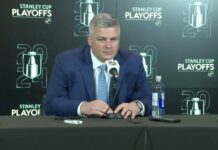





















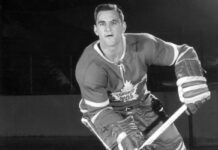
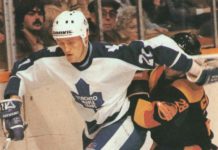
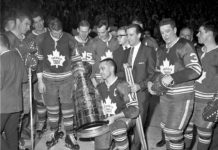

![Jim Montgomery Post Game, Bruins 4 vs. Leafs 2: “[Marchand] still manages to get under people’s skin, yet he doesn’t cross the line” Jim Montgomery, Boston Bruins post game](https://mapleleafshotstove.com/wp-content/uploads/2024/04/jim-monty-pg-to-100x70.jpg)







